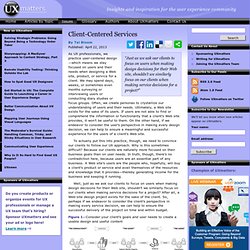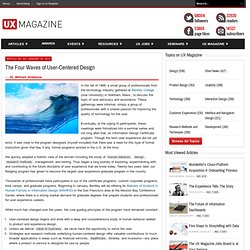

Client-Centered Services. By Tal Bloom Published: April 22, 2013 “Just as we ask our clients to focus on users when making design decisions for their Web site, shouldn’t we similarly focus on our clients when making service decisions for a project?”

As UX professionals, we practice user-centered design—which means we stay focused on users and their needs when designing a Web site, product, or service for a client. We may spend days, weeks, or sometimes even months surveying or interviewing users or conducting diary studies or focus groups. Often, we create personas to crystallize our understanding of users and their needs. To actually put this into practice, though, we need to convince our clients to follow our UX approach. Well, just as we ask our clients to focus on users when making design decisions for their Web site, shouldn’t we similarly focus on our clients when making service decisions for a project? Figure 1—Consider your client’s goals and user needs to create a usable design and useful content. The Four Waves of User-Centered Design. In the fall of 1988, a small group of professionals from the technology industry gathered at Bentley College (now University) in Waltham, Mass., to discuss the topic of user advocacy and assistance.

These gatherings were informal, simply a group of professionals with a shared passion for improving the quality of technology for the user. Eventually, at the urging of participants, these meetings were formalized into a seminar series and, not long after that, an Information Design Certificate program. Though the term user experience did not yet exist, it was clear to the program designers (myself included) that there was a need for this type of formal instruction given that few, if any, formal programs existed in the U.S. at the time. We quickly adopted a holistic view of the domain including the study of human behavior, design, research methods, management, and testing.
While much has changed over the years, the core guiding principles of the program have remained constant: Conclusion. Recommended Usability, UCD, UX Links and Tools - Resources - Paul D. Hibbitts, Vancouver, Canada. Design: UCD process. The Roots of User-Centered Design — Beyond Wireframing: The Real-Life UX Design Process. We all know basic tenets of user-centered design.

We recognize different research methods, the prototyping stage, as well as the process of documenting techniques in our rich methodological environment. The question you probably often ask yourself, though, is how it all works in practice? What do real-life UX design processes actually look like? Do we have time for every step in the process that we claim to be ideal? In this article, I’ll share a couple of insights about the real-life UX design process and speak from my own experience and research. User-Centred Design: Truth Vs. A few years ago, I joined one of the biggest e-commerce companies in Eastern Europe. For the next three years, we worked hard to put user experience design at the heart of a developer-driven culture. To deliver a user interface on time, we were forced to get really lean. Post-launch was the time to measure and plan optimization, which we executed immediately. All in all, our process was simple but efficient. 1.